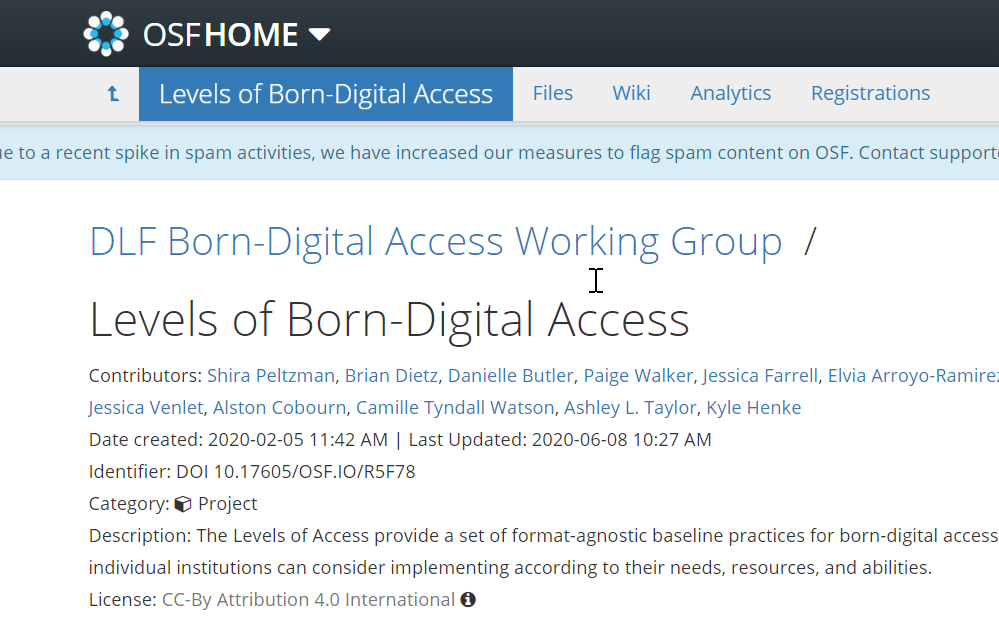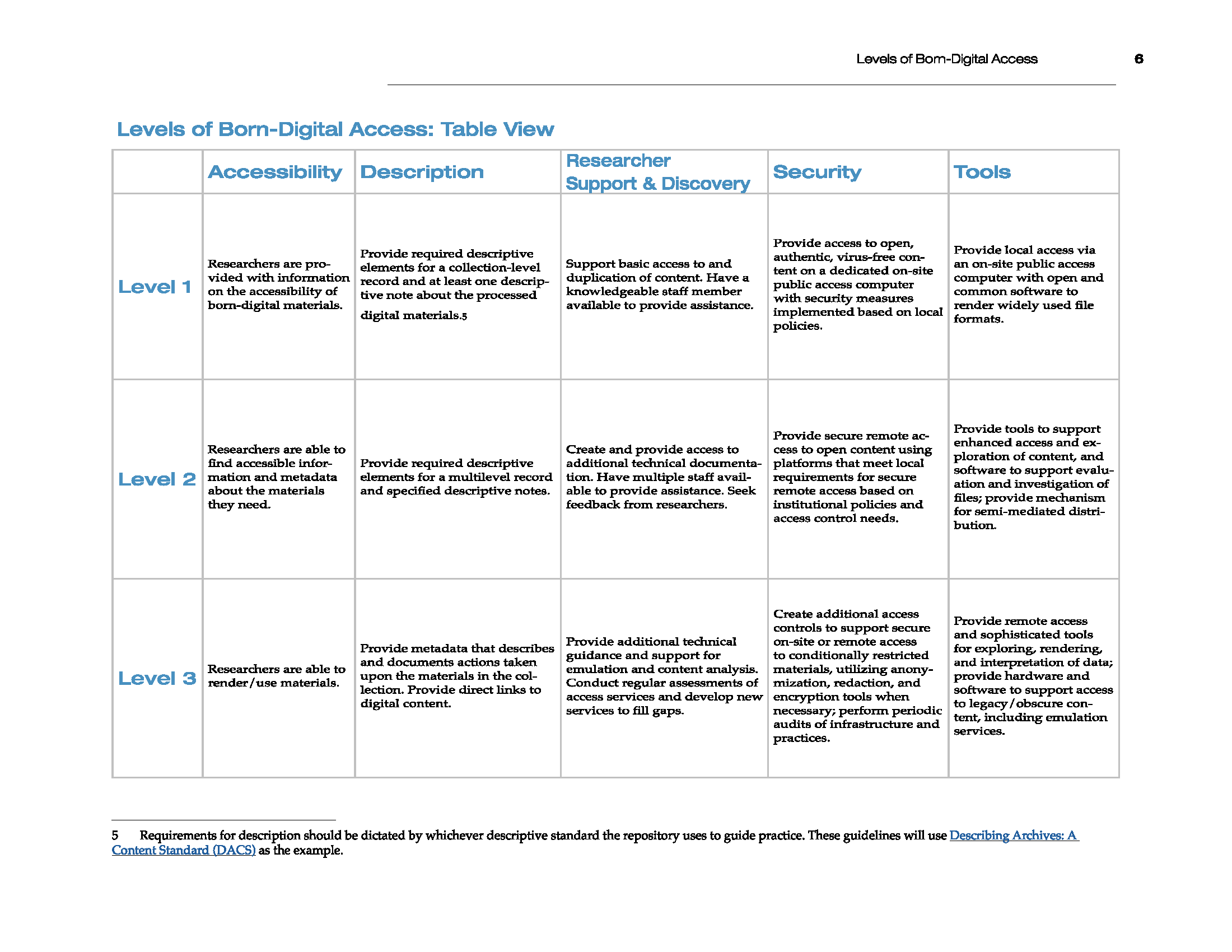Access is foundational to digital preservation. Access is the primary mechanism by which an archive meets its responsibility to its user community. As one of the six functional entities defined by the OAIS Reference Model, access is a common denominator across all institutions regardless of their size, resources, or collection types. Yet, in spite ofthe central role that the access function plays, there is little agreement about what access to digital material should look like in practice or how it might be implemented from institution to institution. The DLF Born-Digital Archives Working Group (BDAWG) sought to address and fill this gap by creating the Levels of Born-Digital Access (LBDA) -- a set of clear benchmarks and practical guidelines supporting access to born-digital materials.

Inspired by the approach taken in the NDSA Levels of Preservation, the LBDA offers a tiered set of format-agnostic practices to facilitate and improve access to born-digital materials. Divided into three tiers (or levels), the LBDA lays out concrete and actionable recommendations in five distinct areas -- Accessibility, Description, Researcher Support and Discovery, Security, and Tools -- that institutions can consider implementing according to their needs, resources, and abilities. Presented in the context of a white paper, the LBDA includes a detailed narrative section for each area that comprises a bulleted list of actions for each of the three levels and accompanying lists of resources, examples, and tips, along with a single-page table that provides an easy visual reference.

The LBDA is the result of a highly collaborative and deliberately iterative drafting process. It grew out of a well attended DLF 2017 Forum working lunch discussion, which led to a large group call for volunteers issued in early 2018. The LBDA, with fourteen contributing authors, is based on a wide-range of practitioner experience. Team members began by splitting into small sub-groups to create an initial draft for each of the five areas that the document addresses. Each sub-group’s draft was peer reviewed by members of another sub-group, as well as by outside BDAWG members.
The team sought feedback on its first draft through conference participation in the fall of 2018. The team ran intensive half-day and hour-long sessions at the BitCurator Users Forum and the Digital Library Federation Forum, respectively, dedicated entirely to workshopping the LBDA with attendees. These workshops served as focus groups with practitioners from across the field. Team members led a series of small group discussions designed to spark conversation and debate around questions related to the LBDA’s design, content, and overall usefulness. These guided conversations yielded rich and nuanced feedback that ultimately persuaded the team to alter its approach and revise the document’s structure and format to better meet the needs and use cases articulated by the workshops’ participants.
Making these changes resulted in a year-long revision process during which the team incorporated participants’ feedback. The revision process had a dramatic impact on the team’s work product. A major area of focus was paring down the tiers to make the document more user-friendly. Originally, the team had envisioned the output of the project as a single grid that would serve as an all-in-one point of reference in the vein of the NDSA Levels of Preservation. However, conversations with workshop participants made it clear that the level of detail made the grid confusing to read and challenging to understand and use. To address this, participants suggested a twofold approach consisting of a simplified grid supplemented by detailed recommendations for each level in that area.
Another significant change that resulted from these conversations was the addition of a “Prerequisites” section, which details the institutional policies and acquisitions practices that undergird any robust born-digital access strategy. This allowed the team to merge the content of what had originally been a sixth area (Policy and Documentation) into this section. The creation of this section further simplified the grid and also provided a necessary foundation and context for the entire document.
In fall 2019, the team released a publicly available draft of the LBDA on Google Drive for a month-long comment period. During this time, members of the cultural heritage community were invited to leave their feedback and suggestions. The comment period was hugely successful. In January 2020 the draft was further revised to incorporate and address the over 170 additional comments and suggestions. These comments played a critical role in ensuring that the LBDA would be relevant across varying institutional contexts. Specifically, based on feedback received from Canadian, British, and New Zealand colleagues, the team made significant revisions to make recommendations even more universally relevant.
The resulting document models a practical approach to access that empowers practitioners to start where they are, strive for gradual improvement, and measure their progress as they move forward. The LBDA can be used and referenced by all cultural heritage institutions seeking to provide onsite access to their born-digital materials. Additionally, to ensure the broadest possible applicability, the LBDA encourages its readers -- particularly those who are working outside the United States and/or with content that has a particularly unique set of needs -- to interpret, reconfigure, and adapt (or ‘fork’ it) for their own needs.
The LBDA OSF attracts hundreds of site unique visits every month. To date, the document is referenced as a resource that can be used to support the development of born-digital access policies in UC Guidelines for Efficient Archival Processing, the National Archives’ (UK) “Archive Service Accreditation–Guidance for developing and completing an application,” and Yale’s forthcoming Born-Digital Collections Access Policy.
The LBDA is a genuinely cooperative, first-of-its-kind resource that is the result of intensive peer engagement and broad participation from across a global community of practitioners. The team employed the structure of a DLF working group to crowd-source guidelines that serve as a de facto professional standard. The team engaged a diverse audience during the drafting process to ensure that the document would be broadly applicable and relevant to changing contexts. This iterative and collaborative approach could be applied across the profession to leverage a more diverse audience in standards creation.






























































































































